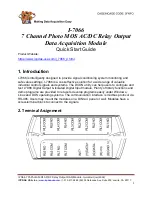
4
|
ni.com
|
NI 6738/6739 Calibration Procedure
Test Conditions
Follow these guidelines to optimize the connections and the environment during calibration.
•
Keep connections to the device as short as possible. Long cables and wires can act as
antennae, which could pick up extra noise that would affect measurements.
•
Verify that all connections to the NI 6738/6739 are secure.
•
Use shielded copper wire for all cable connections to the device. Use twisted-pair wire to
eliminate noise and thermal offsets.
•
Maintain an ambient temperature of 23 °C ± 5 °C throughout the
procedure. The device temperature is greater than the ambient temperature.
Refer to the
section for more information about calibration
temperatures and temperature drift.
•
For valid test limits, maintain the device temperature within ±1 °C from the last
self-calibration and ±10 °C from the last external calibration.
•
Keep relative humidity below 80%.
•
Allow adequate warm-up time of at least 15 minutes to ensure that the measurement
circuitry is at a stable operating temperature.
Calibration Procedure
The calibration process has the following steps.
1.
—Configure your device in NI-DAQmx, adjust the self-calibration constants
of the device, and verify that the current device temperature does not cause you to
incorrectly calibrate your device.
2.
—Verify the existing operation of the device. This step allows you to confirm
that the device was operating within its specified range prior to calibration.
3.
—Perform an external calibration that adjusts the device calibration constants
with respect to a known voltage source.
4.
—When an adjustment procedure is completed, the NI 6738/6739
internal calibration memory (EEPROM) is immediately updated. If you do not want to
perform an adjustment, you can update the calibration date without making any
adjustments.
5.
—Perform another verification to ensure that the device is operating within
its specifications after adjustment.
These steps are described in detail in the following sections.


































